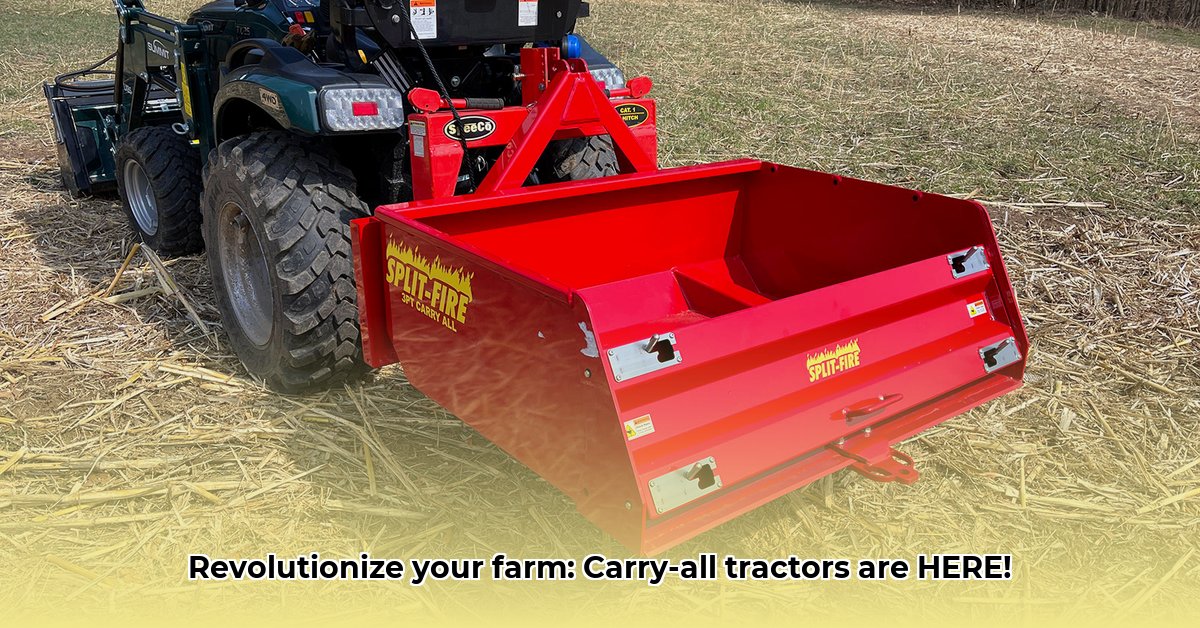
Carry-All Tractors: Revolutionizing Modern Agriculture
Carry-all tractors are transforming agricultural practices, offering significant improvements in efficiency and sustainability. These versatile machines streamline material handling, reducing labor costs and boosting overall productivity. This guide provides a step-by-step approach to integrating carry-all tractors into your farming operation, maximizing their benefits while minimizing environmental impact. We'll cover everything from selecting the right model to implementing long-term sustainable practices. For more information on tractor options, check out this helpful resource: tractor models. Isn't it time to make your farm more efficient and profitable?
Understanding the Advantages of Carry-All Tractors
The benefits of carry-all tractors extend beyond simple material transport. They represent a significant advancement in farm efficiency and sustainability. How much could you save with optimized material handling? Let's explore the key advantages:
- Reduced Labor Costs: Carry-all tractors automate material transport, reducing the need for manual labor and significantly lowering associated costs. Studies show this reduction can reach up to 25% in certain operations.
- Increased Productivity: Efficient material movement streamlines workflow, maximizing output and minimizing downtime. This leads to faster turnaround times on various farm tasks.
- Improved Material Handling: These tractors are designed to safely handle various materials, reducing the risk of damage or spoilage. This means less waste and greater productivity.
- Enhanced Safety: By automating heavy lifting and transport, carry-all tractors significantly reduce the risk of workplace injuries associated with manual material handling.
Selecting the Right Carry-All Tractor: A Comprehensive Guide
Choosing the right tractor is vital for maximizing its benefits. Do you know the critical factors to consider before making a purchase? Here's a detailed guide:
1. Assess Farm Size and Terrain: Larger farms and challenging terrain necessitate robust tractors with superior traction and stability. Smaller farms with flatter terrain can utilize more compact models.
2. Identify Material Handling Needs: The type and weight of materials you transport directly impact the tractor's required capacity and attachments. Consider the size and weight of typical loads to determine the necessary specifications.
3. Budget Wisely: Balance the initial cost with long-term operational expenses, including fuel efficiency and maintenance requirements. A higher upfront cost might prove more economical over time.
4. Consider Operator Experience and Training: Choose a model with user-friendly controls and invest in comprehensive operator training to ensure safe and efficient operation.
Comparative Chart (Example):
| Feature | Small Farm (Flat Terrain) | Medium Farm (Rolling Hills) | Large Farm (Challenging Terrain) |
|---|---|---|---|
| Tractor Size | Compact | Mid-size | Large |
| Lifting Capacity | Low | Medium | High |
| Power (HP) | 25-40 | 40-60 | 60+ |
| Maneuverability | High | Medium | Low |
Safe and Efficient Operation: Prioritizing Safety and Maintenance
Safe operation is paramount. Ignoring safety protocols can lead to accidents, injuries, and costly repairs. Here are some crucial safety and maintenance tips:
1. Secure Loads Properly: Always use appropriate straps and tie-downs to prevent loads from shifting during transport.
2. Follow Manufacturer Guidelines: Adhere strictly to the manufacturer's operating and maintenance instructions for optimal performance and safety.
3. Provide Comprehensive Operator Training: All operators must receive comprehensive training on safe operating procedures, including load securing, maneuvering, and emergency protocols.
4. Implement Regular Maintenance: Regular servicing, including inspections, oil changes, and necessary repairs, extends the tractor's lifespan and minimizes downtime. A well-maintained tractor is a safe tractor. What are the immediate maintenance costs that a carry-all tractor might require?
Integrating Carry-All Tractors into a Sustainable Farming System
Sustainable practices are crucial for the long-term viability of your farm. Carry-all tractors can contribute significantly to your farm's sustainability efforts. How can you minimize the tractor's environmental footprint?
1. Fuel Efficiency: Choose fuel-efficient models and optimize transport routes to reduce fuel consumption and greenhouse gas emissions.
2. Material Selection: Prioritize the use of recycled or sustainable materials whenever possible. This reduces the environmental burden of your operations.
3. End-of-Life Management: Plan for responsible disposal at the end of the tractor's lifespan. Explore recycling or proper dismantling options.
4. Precision Agriculture Integration: Combine the carry-all with precision agriculture technologies, like GPS guidance, to optimize resource use and minimize environmental impact.
Long-Term Sustainability Considerations: Embracing Technological Advancements
Integrating carry-all tractors with precision agriculture technologies opens up exciting opportunities for increased efficiency and improved sustainability. How can you leverage technology to maximize the benefits of your carry-all tractor?
Consider using GPS-guided systems for optimized fertilizer application or automated data-logging for precise tracking of operational efficiency and resource consumption. These strategies will ultimately benefit your bottom line and contribute to a more sustainable farming future.
Case Study: Real-World Success Stories
"Implementing a carry-all tractor reduced our labor costs by 25% and significantly sped up harvest times, allowing us to expand operations without additional labor," said John Miller, owner of Miller Farms in Iowa. His return on investment surpassed all expectations.
Conclusion: Investing in a More Efficient and Sustainable Future
Carry-all tractors offer a compelling solution for improving farm efficiency and sustainability. By carefully considering the factors discussed in this guide, you can select the appropriate model and implement best practices for safe and efficient operation. Investing in a carry-all tractor is an investment in a more profitable and environmentally responsible future for your farm. Are you ready to take the next step towards optimizing your agricultural operations?